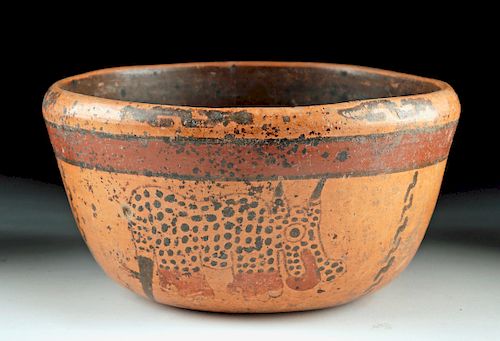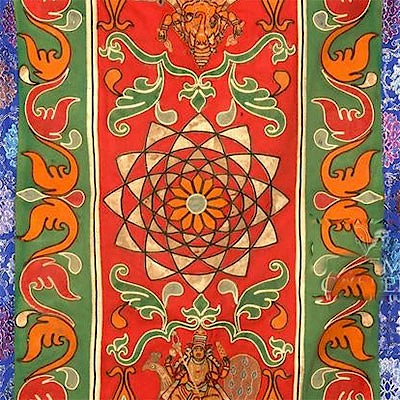Maya Polychrome Bowl w/ Jaguar Motif
Lot 411
About Seller
Artemis Gallery
686 S Taylor Ave, Ste 106
Louisville, CO 80027
United States
Selling antiquities, ancient and ethnographic art online since 1993, Artemis Gallery specializes in Classical Antiquities (Egyptian, Greek, Roman, Near Eastern), Asian, Pre-Columbian, African / Tribal / Oceanographic art. Our extensive inventory includes pottery, stone, metal, wood, glass and textil...Read more
Estimate:
$1,000 - $1,500
Absentee vs Live bid
Two ways to bid:
- Leave a max absentee bid and the platform will bid on your behalf up to your maximum bid during the live auction.
- Bid live during the auction and your bids will be submitted real-time to the auctioneer.
Bid Increments
| Price | Bid Increment |
|---|---|
| $0 | $25 |
| $300 | $50 |
| $1,000 | $100 |
| $2,000 | $250 |
| $5,000 | $500 |
| $10,000 | $1,000 |
| $20,000 | $2,500 |
| $50,000 | $5,000 |
| $100,000 | $10,000 |
| $200,000 | $20,000 |
About Auction
By Artemis Gallery
Oct 17, 2019
Set Reminder
2019-10-17 10:00:00
2019-10-17 10:00:00
America/New_York
Bidsquare
Bidsquare : Early Fall Variety | Ancient & Ethnographic
https://www.bidsquare.com/auctions/artemis-gallery/early-fall-variety-ancient-ethnographic-4538
Discover incredible lots relisted with new, lower start prices (up to 50% less), plus many items brand-new to auction. Step back in time and around the world – you’ll be amazed at the treasures you will find. Antiquities from the Classics, Asian, Pre-Columbian African and much more! Artemis Gallery info@artemisgallery.com
Discover incredible lots relisted with new, lower start prices (up to 50% less), plus many items brand-new to auction. Step back in time and around the world – you’ll be amazed at the treasures you will find. Antiquities from the Classics, Asian, Pre-Columbian African and much more! Artemis Gallery info@artemisgallery.com
- Lot Description
**Originally Listed At $500**
Pre-Columbian, Honduras, Maya, Late Classic Period, ca. 550 to 900 CE. A hand-built pottery bowl resting on a concave base. A solid stripe of brown pigment lines the inside of the rim, and the entire bowl is presented with a pale orange ground. The exterior displays a register of 3 highly-stylized jaguars with stocky legs, conical tails, spotted bodies, and large heads with pointed ears and hanging tongues. Each feline is separated from its neighbors by a column of stacked 'S' forms and are topped with a solid vermilion band outlined in dark-brown. Size: 6.375" W x 3.3" H (16.2 cm x 8.4 cm).
The form of the jaguar was revered throughout the Pre-Columbian New World as the mightiest wild feline and was used as a symbol of power and kingship. In Classic Maya art, the jaguar is associated with lordly might and as an avatar for the gods. Many rulers during this time took jaguar names: Shield-Jaguar and Bird-Jaguar, for example. One of the Hero Twins described in the Quiche book Popol Voh, the most famous Maya text, is named Xbalanque, which is almost certainly derived from the word for jaguar, "balam", and that twin is shown in art with jaguar pelt markings on his face and body.
Provenance: private southwestern Pennsylvania, USA collection
All items legal to buy/sell under U.S. Statute covering cultural patrimony Code 2600, CHAPTER 14, and are guaranteed to be as described or your money back.
A Certificate of Authenticity will accompany all winning bids.
We ship worldwide and handle all shipping in-house for your convenience.
#144753Professionally repaired from a few large pieces with resurfacing and overpainting along break lines. Small nicks and chips to rim, body, and base, with fading to original pigmentation, and a few small excisions. Nice earthen deposits, manganese blooms, and root marks throughout.Condition
- Shipping Info
-
All shipping is handled in-house for your convenience. Your invoice from Artemis Gallery will include shipping calculation instructions. If in doubt, please inquire BEFORE bidding for estimated shipping costs for individual items.
-
- Buyer's Premium



 EUR
EUR CAD
CAD AUD
AUD GBP
GBP MXN
MXN HKD
HKD CNY
CNY MYR
MYR SEK
SEK SGD
SGD CHF
CHF THB
THB
















